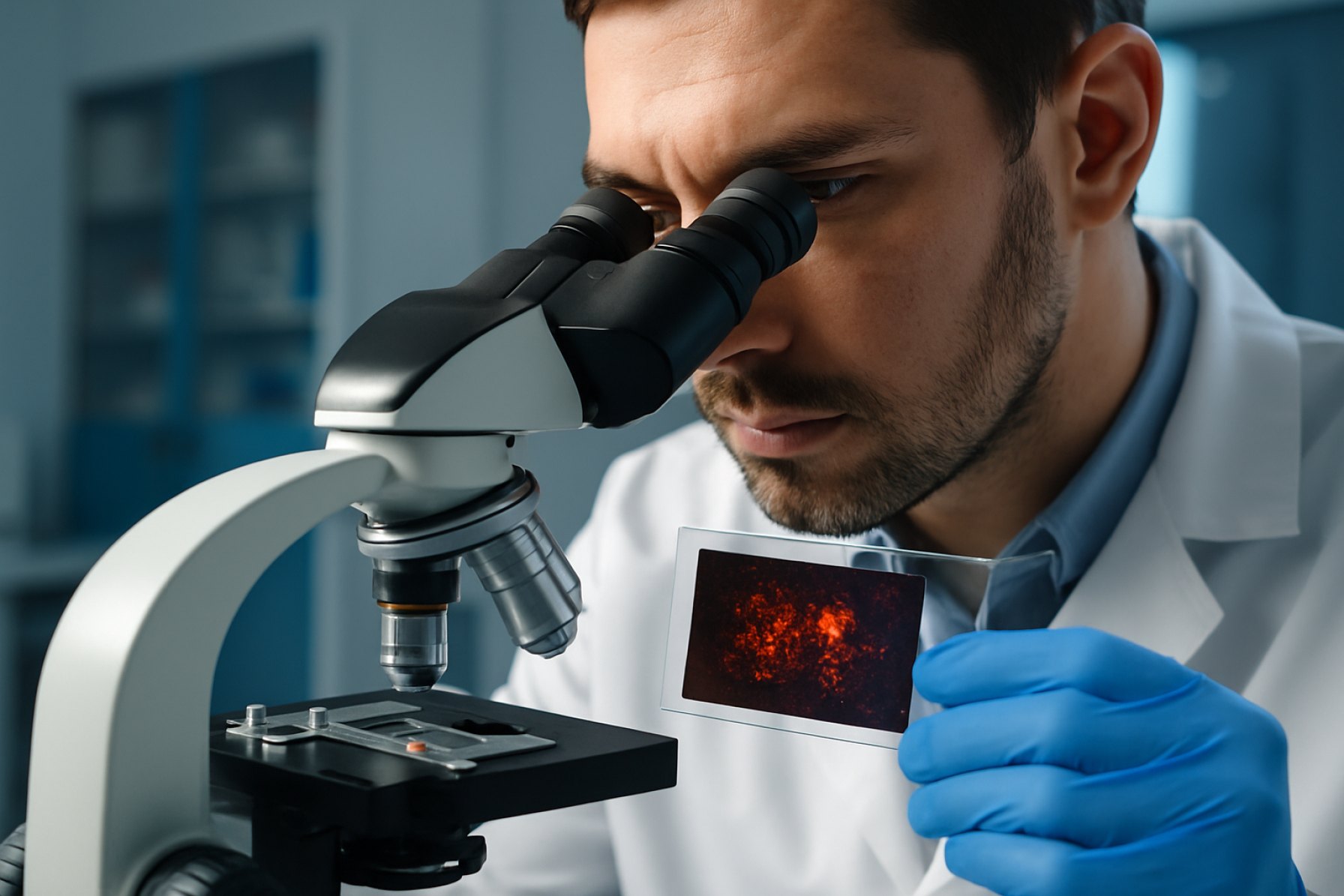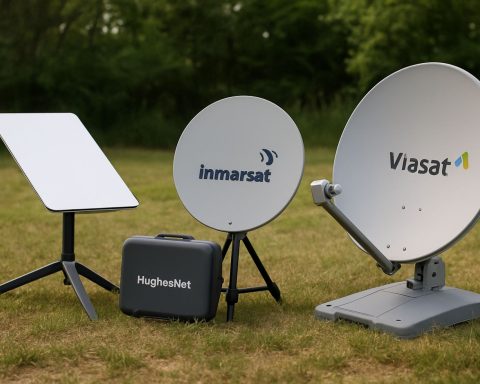Nanoparticle-Based Biophotonics in 2025: Unleashing Precision in Medical Imaging and Sensing. Explore How Advanced Nanomaterials Are Transforming Healthcare and Research for the Next Five Years.
- Executive Summary: Key Trends and Market Drivers
- Market Size and 2025–2030 Growth Forecast (18% CAGR)
- Core Nanoparticle Technologies in Biophotonics
- Breakthrough Applications: Imaging, Sensing, and Therapy
- Competitive Landscape: Leading Companies and Innovators
- Regulatory Environment and Industry Standards
- Challenges: Biocompatibility, Scalability, and Cost
- Emerging Markets and Regional Opportunities
- Strategic Partnerships and Investment Trends
- Future Outlook: Next-Gen Nanoparticle Biophotonics (2030 and Beyond)
- Sources & References
Executive Summary: Key Trends and Market Drivers
Nanoparticle-based biophotonics is rapidly emerging as a transformative field at the intersection of nanotechnology, photonics, and biomedical sciences. In 2025, the sector is characterized by accelerated innovation, driven by the convergence of advanced nanoparticle engineering and the growing demand for high-sensitivity diagnostic and therapeutic tools. Key trends shaping the market include the integration of multifunctional nanoparticles for imaging and therapy, the expansion of clinical applications, and the increasing role of industry-academic collaborations.
A major driver is the ongoing refinement of nanoparticle synthesis, enabling precise control over size, shape, and surface chemistry. This has led to the development of nanoparticles with enhanced optical properties, such as gold nanorods and quantum dots, which are now being incorporated into next-generation imaging agents and photothermal therapies. Companies like Thermo Fisher Scientific and Sigma-Aldrich (a subsidiary of Merck KGaA) are at the forefront, supplying a broad portfolio of nanoparticles tailored for biophotonic applications, including fluorescent and plasmonic nanomaterials.
The clinical translation of nanoparticle-based biophotonics is gaining momentum, particularly in oncology and infectious disease diagnostics. The adoption of nanoparticle-enhanced imaging modalities—such as surface-enhanced Raman scattering (SERS) and near-infrared fluorescence—has improved the sensitivity and specificity of early disease detection. For example, nanoComposix (now part of Fortis Life Sciences) specializes in custom nanoparticles for SERS and other optical applications, supporting both research and commercial diagnostic platforms.
Regulatory progress and standardization efforts are also shaping the landscape. Organizations such as International Organization for Standardization (ISO) and ASTM International are actively developing guidelines for the characterization and safe use of nanomaterials in biophotonic devices, which is expected to facilitate broader clinical adoption in the coming years.
Looking ahead, the market outlook for nanoparticle-based biophotonics remains robust. The sector is poised for continued growth, fueled by rising investment in precision medicine, the expansion of point-of-care diagnostics, and the integration of artificial intelligence for image analysis. Strategic partnerships between technology providers, such as Thermo Fisher Scientific, and leading research institutions are expected to accelerate the commercialization of novel nanoparticle-enabled biophotonic solutions through 2025 and beyond.
Market Size and 2025–2030 Growth Forecast (18% CAGR)
The global market for nanoparticle-based biophotonics is poised for robust expansion, with an estimated compound annual growth rate (CAGR) of approximately 18% from 2025 through 2030. This growth trajectory is driven by accelerating adoption of advanced nanomaterials in biomedical imaging, diagnostics, and therapeutic applications. In 2025, the market is projected to surpass USD 2.5 billion, underpinned by increasing investments in nanotechnology-enabled photonic devices and the rising prevalence of chronic diseases requiring early and precise detection.
Key industry players are intensifying their research and commercialization efforts. Thermo Fisher Scientific continues to expand its portfolio of nanoparticle reagents and quantum dot technologies for fluorescence imaging and biosensing. Bruker Corporation is advancing nanoparticle-based imaging platforms, particularly in preclinical and translational research. Oxford Instruments is also contributing to the sector with its expertise in nanomaterial characterization and photonic instrumentation, supporting the development of next-generation biophotonic tools.
The market’s momentum is further bolstered by the integration of nanoparticles—such as gold, silica, and quantum dots—into photonic systems for enhanced sensitivity and multiplexing capabilities. These advances are enabling breakthroughs in real-time, non-invasive diagnostics and targeted therapies. For instance, gold nanoparticles are increasingly utilized in photothermal therapy and as contrast agents in optical coherence tomography, while quantum dots are gaining traction for their superior brightness and stability in multiplexed bioimaging.
Geographically, North America and Europe are expected to maintain leading positions due to strong R&D infrastructure and supportive regulatory environments. However, Asia-Pacific is anticipated to witness the fastest growth, propelled by expanding healthcare investments and the emergence of local nanotechnology innovators. Companies such as nanoComposix (now part of Fisher Scientific) are actively supplying custom nanoparticles for research and clinical applications worldwide.
Looking ahead to 2030, the nanoparticle-based biophotonics market is forecast to exceed USD 5.7 billion, as clinical translation of nanophotonic diagnostics and therapies accelerates. Ongoing collaborations between industry leaders, academic institutions, and healthcare providers are expected to drive further innovation, regulatory approvals, and market penetration, solidifying nanoparticle-enabled biophotonics as a cornerstone of next-generation biomedical technology.
Core Nanoparticle Technologies in Biophotonics
Nanoparticle-based biophotonics is rapidly advancing as a core technology in biomedical imaging, diagnostics, and therapy. In 2025, the field is characterized by the integration of engineered nanoparticles—such as quantum dots, gold nanoparticles, and upconversion nanoparticles—into photonic systems for enhanced sensitivity, specificity, and multifunctionality. These nanomaterials are being tailored for applications ranging from in vivo imaging to photothermal therapy, leveraging their unique optical properties and biocompatibility.
Quantum dots (QDs) remain at the forefront due to their tunable emission spectra and high photostability. Companies like Thermo Fisher Scientific and Sigma-Aldrich (a subsidiary of Merck KGaA) are major suppliers of QDs for research and clinical translation, offering a range of surface-modified nanoparticles for targeted imaging. In 2025, the focus is on developing heavy-metal-free QDs to address toxicity concerns, with silicon and carbon-based QDs gaining traction for in vivo applications.
Gold nanoparticles (AuNPs) are another cornerstone, valued for their strong plasmonic resonance and ease of functionalization. BBI Solutions and nanoComposix (now part of Fortis Life Sciences) are prominent manufacturers, providing AuNPs in various shapes and sizes for use in biosensing, photothermal therapy, and multiplexed imaging. Recent developments emphasize the use of anisotropic gold nanostructures, such as nanorods and nanoshells, which offer tunable absorption in the near-infrared (NIR) region—ideal for deep tissue imaging and minimally invasive therapies.
Upconversion nanoparticles (UCNPs), which convert NIR light to visible emission, are gaining momentum for their ability to minimize background autofluorescence and enable deep tissue imaging. Creative Diagnostics and Ocean Insight are among the suppliers advancing UCNPs for multiplexed bioassays and in vivo tracking. The next few years are expected to see further improvements in quantum efficiency and surface chemistry, facilitating clinical translation.
Magnetic-plasmonic hybrid nanoparticles are emerging as multifunctional platforms, combining magnetic resonance imaging (MRI) contrast with photonic capabilities for theranostics. Companies such as Chemicell are developing these hybrid systems, which are anticipated to play a significant role in personalized medicine by enabling simultaneous diagnosis and therapy.
Looking ahead, the outlook for nanoparticle-based biophotonics is robust. The convergence of nanotechnology, photonics, and biotechnology is expected to yield next-generation diagnostic and therapeutic tools with higher precision and lower toxicity. Regulatory progress and scalable manufacturing by industry leaders will be critical for clinical adoption, with ongoing collaborations between academia and companies like Thermo Fisher Scientific and Sigma-Aldrich driving innovation toward real-world healthcare solutions.
Breakthrough Applications: Imaging, Sensing, and Therapy
Nanoparticle-based biophotonics is rapidly transforming the landscape of biomedical imaging, sensing, and therapy, with 2025 poised to see significant clinical and commercial advances. The unique optical properties of nanoparticles—such as quantum dots, gold nanorods, and upconversion nanoparticles—enable highly sensitive detection and targeted intervention at the cellular and molecular levels.
In imaging, nanoparticles are enhancing both resolution and specificity. Quantum dots, for example, offer tunable fluorescence and exceptional photostability, making them ideal for multiplexed imaging in live tissues. Companies like Thermo Fisher Scientific and Sigma-Aldrich (a subsidiary of Merck KGaA) are supplying a broad range of quantum dot reagents for research and preclinical applications. Gold nanoparticles, with their strong plasmonic resonance, are being integrated into photoacoustic imaging systems, providing high-contrast visualization of tumors and vascular structures. Nanopartz Inc. specializes in gold nanoparticle products tailored for biomedical imaging and therapy.
In biosensing, nanoparticles are enabling ultra-sensitive detection of biomarkers for early disease diagnosis. Surface-enhanced Raman scattering (SERS) substrates, often based on silver or gold nanoparticles, are being commercialized for point-of-care diagnostics. HORIBA and Renishaw are among the companies advancing SERS-based platforms for clinical and research use. These systems can detect minute concentrations of cancer or infectious disease markers, with ongoing efforts to integrate them into compact, user-friendly devices.
Therapeutically, nanoparticles are at the forefront of photothermal and photodynamic therapies. Gold nanorods and nanoshells, when irradiated with near-infrared light, convert energy into heat, selectively ablating cancer cells while sparing healthy tissue. Nanospectra Biosciences is advancing clinical trials of its AuroShell technology for solid tumor ablation. Upconversion nanoparticles, which emit visible light upon near-infrared excitation, are being explored for deep-tissue photodynamic therapy, with research collaborations involving major academic centers and industry partners.
Looking ahead, the next few years are expected to bring further integration of nanoparticle-based biophotonics with artificial intelligence and microfluidics, enabling real-time, in vivo diagnostics and image-guided therapies. Regulatory progress and standardization efforts, led by organizations such as ISO, will be crucial for clinical translation. As manufacturing capabilities scale and new surface chemistries improve biocompatibility, nanoparticle-enabled biophotonics is set to become a cornerstone of precision medicine by the late 2020s.
Competitive Landscape: Leading Companies and Innovators
The competitive landscape of nanoparticle-based biophotonics in 2025 is characterized by a dynamic mix of established industry leaders, innovative startups, and academic spin-offs, all driving advancements in diagnostics, imaging, and therapeutic applications. The sector is witnessing rapid growth, propelled by the convergence of nanotechnology and photonics, with a focus on precision medicine, minimally invasive diagnostics, and real-time monitoring.
Among the global leaders, Thermo Fisher Scientific continues to play a pivotal role, leveraging its extensive portfolio of nanoparticle reagents, quantum dots, and advanced imaging platforms. The company’s investments in nanoparticle-based fluorescent probes and multiplexed detection systems have positioned it as a key supplier to both research and clinical laboratories. Similarly, Bruker Corporation is expanding its biophotonics offerings, integrating nanoparticle-enhanced imaging modalities into its advanced microscopy and spectroscopy systems, targeting both life sciences and medical diagnostics.
In the Asia-Pacific region, HORIBA, Ltd. is notable for its innovations in nanoparticle characterization and fluorescence spectroscopy, supporting the development of new biophotonic assays and point-of-care devices. The company’s collaborations with academic and clinical partners are accelerating the translation of nanoparticle-based technologies into practical healthcare solutions.
Startups and university spin-offs are also shaping the competitive landscape. Companies such as nanoComposix (now part of Fortis Life Sciences) are recognized for their custom-engineered nanoparticles, which are widely used in research and commercial biophotonics applications, including biosensing and in vivo imaging. Their expertise in surface modification and particle uniformity is critical for reproducible and sensitive assays.
Meanwhile, Oxford Instruments is advancing nanoparticle-based imaging through its high-resolution microscopy platforms, enabling researchers to visualize and quantify nanoparticle interactions in biological systems with unprecedented detail. The company’s focus on integrating AI-driven analysis tools is expected to further enhance the utility of biophotonic data in clinical and research settings.
Looking ahead, the competitive landscape is expected to intensify as regulatory approvals for nanoparticle-based diagnostic and therapeutic products increase. Strategic partnerships between technology providers, pharmaceutical companies, and healthcare institutions are anticipated to accelerate commercialization. The next few years will likely see further consolidation, with major players acquiring innovative startups to expand their capabilities in targeted imaging, photothermal therapy, and multiplexed diagnostics, solidifying the role of nanoparticle-based biophotonics in precision medicine.
Regulatory Environment and Industry Standards
The regulatory environment for nanoparticle-based biophotonics is rapidly evolving as the technology matures and its applications in diagnostics, imaging, and therapeutics expand. In 2025, regulatory agencies are intensifying their focus on the unique challenges posed by nanoparticles, particularly regarding safety, efficacy, and environmental impact. The U.S. Food and Drug Administration (U.S. Food and Drug Administration) continues to update its guidance for nanotechnology products, emphasizing the need for robust characterization, toxicological assessment, and clear labeling. The FDA’s Nanotechnology Task Force is actively collaborating with industry stakeholders to refine standards for clinical evaluation and post-market surveillance of nanoparticle-enabled devices and drugs.
In the European Union, the European Medicines Agency (European Medicines Agency) and the European Commission are harmonizing regulations under the Medical Device Regulation (MDR) and In Vitro Diagnostic Regulation (IVDR), both of which now explicitly address nanomaterials. These frameworks require manufacturers to provide detailed risk assessments and lifecycle analyses for products incorporating nanoparticles, including those used in biophotonic imaging and therapy. The European Committee for Standardization (CEN) is also working on technical standards for the characterization and testing of nanomaterials, aiming to facilitate cross-border market access and ensure patient safety.
Industry groups such as the International Organization for Standardization (ISO) and ASTM International (ASTM International) are accelerating the development of consensus standards for nanoparticle synthesis, surface modification, and biocompatibility testing. These standards are increasingly referenced by regulatory bodies and are critical for companies seeking global market approval. For example, ISO’s Technical Committee 229 focuses on nanotechnologies, including protocols for measuring optical properties and toxicity relevant to biophotonics.
Major industry players, including Thermo Fisher Scientific and Bruker Corporation, are actively participating in regulatory consultations and standardization initiatives. These companies are investing in compliance infrastructure and collaborating with regulators to ensure their nanoparticle-based biophotonic products meet emerging requirements. Additionally, MilliporeSigma (the U.S. and Canada life science business of Merck KGaA) is contributing to the development of reference materials and validated protocols for nanoparticle characterization.
Looking ahead, the next few years are expected to bring greater regulatory clarity and more harmonized international standards, which will be crucial for accelerating clinical translation and commercialization of nanoparticle-based biophotonics. Ongoing dialogue between regulators, industry, and standardization bodies will be essential to address evolving safety concerns and to foster innovation while protecting public health.
Challenges: Biocompatibility, Scalability, and Cost
Nanoparticle-based biophotonics is poised to revolutionize diagnostics, imaging, and therapeutic modalities, but its widespread adoption in 2025 and the near future is constrained by several persistent challenges—chief among them biocompatibility, scalability, and cost. As the field matures, these hurdles are increasingly the focus of both academic and industrial innovation.
Biocompatibility remains a critical concern, as nanoparticles must interact safely with biological systems. The surface chemistry, size, and composition of nanoparticles can provoke immune responses or toxicity, limiting their clinical translation. Companies such as Thermo Fisher Scientific and Sigma-Aldrich (now part of Merck KGaA) are actively developing surface modification techniques—such as PEGylation and biomimetic coatings—to reduce immunogenicity and enhance circulation times. However, regulatory agencies continue to demand extensive in vivo safety data, which can slow the path to approval. In 2025, the industry is seeing a push toward biodegradable and naturally derived nanoparticles, with Creative Biolabs and others exploring protein- and lipid-based nanostructures to address long-term safety concerns.
Scalability is another major bottleneck. While laboratory synthesis of nanoparticles can be tightly controlled, translating these processes to industrial scale without compromising uniformity or functionality is challenging. nanoComposix (a Fortis Life Sciences company) and MilliporeSigma (the U.S. and Canada life science business of Merck KGaA) are among the few suppliers offering GMP-grade nanoparticles for clinical and commercial use, but even these leaders face hurdles in batch-to-batch consistency and process validation. Automation and continuous flow synthesis are being adopted to improve reproducibility, but the capital investment required remains high, especially for startups and academic spinouts.
Cost is intrinsically linked to both biocompatibility and scalability. The need for high-purity reagents, specialized equipment, and rigorous quality control drives up production expenses. As of 2025, the price of clinical-grade nanoparticles remains a significant barrier for many applications, particularly in resource-limited settings. Companies like Thermo Fisher Scientific and Sigma-Aldrich are working to streamline supply chains and scale up production, but the cost per milligram for advanced nanoparticles (e.g., gold nanorods, quantum dots) is still orders of magnitude higher than conventional dyes or contrast agents.
Looking ahead, the sector is expected to benefit from advances in green chemistry, modular manufacturing, and regulatory harmonization. However, overcoming the intertwined challenges of biocompatibility, scalability, and cost will require sustained collaboration between material scientists, engineers, and regulatory bodies. The next few years will likely see incremental progress, with breakthroughs in one area (such as scalable synthesis) potentially unlocking advances in others, ultimately paving the way for broader clinical adoption of nanoparticle-based biophotonics.
Emerging Markets and Regional Opportunities
The global landscape for nanoparticle-based biophotonics is rapidly evolving, with emerging markets and regional opportunities shaping the sector’s trajectory in 2025 and beyond. Biophotonics, which leverages the interaction of light with biological materials, is increasingly enhanced by the integration of nanoparticles—enabling breakthroughs in imaging, diagnostics, and therapeutics. The convergence of nanotechnology and photonics is particularly pronounced in regions investing heavily in healthcare innovation, advanced manufacturing, and life sciences infrastructure.
Asia-Pacific is poised to be a major growth engine, driven by robust investments in nanotechnology and biotechnology. China, in particular, has prioritized nanomedicine and photonics as part of its national innovation agenda, with significant funding channeled into research institutes and industrial parks. Companies such as Nanoshel and Nanotechnology Company are expanding their portfolios to include gold, silver, and silica nanoparticles tailored for biophotonic applications, targeting both domestic and international markets. India is also emerging as a key player, with government-backed initiatives supporting startups and academic-industry collaborations in nanoparticle synthesis and biophotonic device development.
In North America, the United States remains at the forefront, propelled by a strong ecosystem of academic research, venture capital, and established industry players. Companies like Thermo Fisher Scientific and MilliporeSigma (the life science business of Merck KGaA) are actively developing and supplying nanoparticles for use in advanced imaging systems, biosensors, and photothermal therapies. The U.S. Food and Drug Administration’s evolving regulatory framework for nanomaterials in medical devices is expected to further catalyze market adoption, especially as clinical validation of nanoparticle-enabled biophotonic tools accelerates.
Europe is witnessing a surge in public-private partnerships and cross-border research consortia, particularly in Germany, the UK, and the Nordic countries. Organizations such as Creative Diagnostics are expanding their offerings in nanoparticle conjugates for biophotonic assays, while regional funding programs are supporting translational research and commercialization. The European Union’s Horizon Europe program continues to prioritize nanobiophotonics, fostering collaboration between SMEs, universities, and healthcare providers.
Looking ahead, the next few years are expected to see increased localization of nanoparticle manufacturing, with regional supply chains being established to ensure quality control and regulatory compliance. Emerging markets in Latin America and the Middle East are also beginning to invest in biophotonics infrastructure, presenting new opportunities for technology transfer and market entry. As global demand for precision diagnostics and minimally invasive therapies grows, regional hubs with strong R&D capabilities and supportive policy environments are likely to capture a significant share of the nanoparticle-based biophotonics market.
Strategic Partnerships and Investment Trends
The landscape of nanoparticle-based biophotonics is rapidly evolving, with strategic partnerships and investment trends in 2025 reflecting a strong emphasis on translational research, commercialization, and cross-sector collaboration. As the demand for advanced diagnostic and therapeutic tools grows, major industry players and research institutions are forming alliances to accelerate the development and deployment of nanoparticle-enabled biophotonic technologies.
A notable trend is the increasing collaboration between nanomaterials manufacturers and medical device companies. For example, Thermo Fisher Scientific, a global leader in scientific instrumentation and reagents, has expanded its partnerships with biotechnology firms to integrate its nanoparticle synthesis capabilities into next-generation imaging and biosensing platforms. Similarly, Bruker Corporation is leveraging its expertise in analytical instrumentation to support startups and academic spin-offs focused on nanoparticle-based optical imaging and spectroscopy.
Investment activity in 2025 is characterized by both venture capital inflows and strategic corporate investments. Companies such as Illumina and Agilent Technologies are actively investing in early-stage ventures developing nanoparticle-based contrast agents and photonic biosensors, aiming to expand their portfolios in precision diagnostics and personalized medicine. These investments are often accompanied by co-development agreements, ensuring that innovative nanoparticle formulations are compatible with established biophotonic platforms.
On the public sector front, government-backed initiatives in the United States, European Union, and Asia-Pacific are fostering public-private partnerships to bridge the gap between laboratory research and clinical application. Organizations such as the National Institutes of Health (NIH) are funding consortia that bring together academic researchers, industry partners, and regulatory experts to address challenges in nanoparticle safety, scalability, and regulatory approval.
Looking ahead, the next few years are expected to see a surge in cross-disciplinary alliances, particularly between nanotechnology firms and companies specializing in photonic integration and data analytics. The emergence of quantum dot-based imaging agents and plasmonic nanoparticles for real-time biosensing is likely to attract further investment from both established players and new entrants. As regulatory frameworks for nanomedicine mature, strategic partnerships will play a pivotal role in navigating clinical translation and market adoption, positioning nanoparticle-based biophotonics as a cornerstone of future biomedical innovation.
Future Outlook: Next-Gen Nanoparticle Biophotonics (2030 and Beyond)
The field of nanoparticle-based biophotonics is poised for significant advancements as we approach 2025 and look toward the next decade. This interdisciplinary area leverages the unique optical properties of nanoparticles—such as quantum dots, gold nanorods, and upconversion nanoparticles—for applications in imaging, diagnostics, and therapy. The convergence of nanotechnology and photonics is expected to drive transformative changes in biomedical research, clinical diagnostics, and personalized medicine.
In 2025, the focus remains on enhancing the sensitivity, specificity, and multiplexing capabilities of nanoparticle-based imaging agents. Companies like Thermo Fisher Scientific and Sigma-Aldrich (now part of Merck KGaA) are actively developing and supplying a wide range of functionalized nanoparticles for research and clinical use. These nanoparticles are engineered to target specific biomarkers, enabling early detection of diseases such as cancer and neurodegenerative disorders. The integration of nanoparticles with advanced photonic systems, including super-resolution microscopy and multimodal imaging platforms, is expected to further improve diagnostic accuracy and enable real-time, in vivo imaging at the cellular and molecular levels.
Therapeutic applications are also gaining momentum. Gold nanoparticles, for example, are being explored for photothermal therapy, where they convert light into heat to selectively destroy cancer cells. nanoComposix, a subsidiary of Fisher Scientific, is a notable supplier of precisely engineered gold and silver nanoparticles tailored for such biomedical applications. Meanwhile, upconversion nanoparticles, which emit visible light upon near-infrared excitation, are being developed for deep-tissue imaging and controlled drug delivery, with research collaborations involving academic institutions and industry partners.
Looking ahead to 2030 and beyond, the outlook for nanoparticle-based biophotonics is highly promising. The next generation of nanoparticles is expected to feature enhanced biocompatibility, tunable optical properties, and integrated functionalities such as drug loading and release, biosensing, and real-time feedback. The adoption of artificial intelligence and machine learning for image analysis and interpretation will further accelerate the translation of these technologies into clinical practice. Regulatory agencies and industry leaders, including U.S. Food and Drug Administration (FDA) and Roche, are anticipated to play key roles in establishing safety standards and facilitating the commercialization of nanoparticle-enabled biophotonic devices.
Overall, the synergy between nanotechnology and photonics is set to revolutionize biomedical imaging and therapy, with the potential to enable earlier disease detection, more precise treatments, and improved patient outcomes in the coming years.
Sources & References
- Thermo Fisher Scientific
- International Organization for Standardization (ISO)
- ASTM International
- Bruker Corporation
- Oxford Instruments
- Fisher Scientific
- Creative Diagnostics
- Ocean Insight
- HORIBA
- Renishaw
- Nanospectra Biosciences
- European Medicines Agency
- CEN
- MilliporeSigma
- Nanoshel
- Nanotechnology Company
- Illumina
- National Institutes of Health
- Roche











